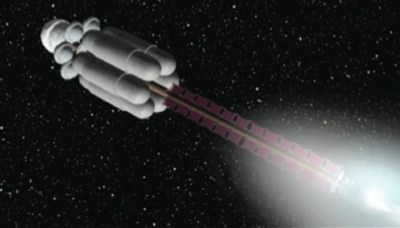Funding the seed corn of advanced space technologyby Lou Friedman
|
| The final budget has no money specified for space technology! No planting of seed corn. |
This takes place in a larger context of global economic and financial woes, the several wars in which we are now engaged, and increasing energy prices. The larger context means that we cannot credibly or usefully advocate bigger budgets for better and increased space programs. We have to argue for smarter budgets. Since biblical times this has meant not trying to simply harvest more, but to spend some small fraction of resources planting seed corn.
Investing in space technology is critical to our fundamental space policy challenge: do more for less. Space technology investment was drastically cut back in the past decade. The Augustine Committee and the administration recognized that approach would only lead to costly and unsustainable programs. If we can’t invent and create new engineering and science solutions, we will have to accept cutting back the old approaches to meet the fiscal constraints. As the fiscal year 2011 budget was formulated in Congress, this seemed to have been accepted: both the administration and the House and Senate authorization and appropriations committees supported new funding and new emphasis for new programs in space technology. But Congress couldn’t actually work the budget details and dropped all the committee work in favor of the continuing resolution. The final budget has no money specified for space technology! No planting of seed corn.
Accepting that baseball is a metaphor for life (a saying attributed to former Yale University president and baseball commissioner, Bart Giamatti) this is like eliminating the farm clubs in order to get money to build new luxury boxes in the stadium. We might make money next year, but the future will be bleak.
There is so much to do in the universe and on our planet. If we choose not to plant our seed corn, though, those efforts will only get more expensive and more out of reach. Costs for launch, in-space propulsion, life support, communications, power, instrumentation, science instruments and robotics will continue to skyrocket (space-rocket!), and we will do less. Conversely, if we stimulate these technologies with grants and innovative programs, we have a chance of not just thinking out of the box but actually getting out of the box and escaping those constraints that now make us despair. The electronics revolution is a harbinger of what is possible. Nanotechnology and information processing will make things weigh and cost less while providing new benefits to apply both in space and on Earth.
| The bounty I seek is the generation of new accomplishments in space science and exploration. |
As important as advanced technology development is for increased science and exploration, it is my view that the technical benefits are less important than the societal benefits of passing achievements and knowledge to a future generation. A zero (or miniscule) budget for space technology in NASA is a statement of giving up the American dream of greatness for future generations. The same goes for Europe, China, Russia, Japan, India, and all others. Will they follow the US lead and give up their dreams and aspirations? Personally, I am an internationalist: happy to see other countries advance technology for science, exploration, and peaceful benefits for their populations. But I am also a competitor who wants my own country to do its best. Using another baseball metaphor: as good as I want the other players on Earth’s space team to be, I want the U.S, to be the best it can be.
In the next few months we will see if our Congress also wants to be the best. On the table is a new budget for fiscal year 2012. It picks up on what should have been started in 2011. A budget of approximately $1 billion is proposed for Space Technology: $310 million sorely needed for the future of Exploration, $430 million for “cross-cutting” activities—the roadmap activities so carefully thought out by the National Academy of Sciences and other advisory groups—and $284 million for technology transfer, commercialization, and small business programs. Economic studies suggest that the $1-billion investment in seed corn would lead to a harvest of nearly $3 billion as well as the generation of some 20,000 jobs. But the bounty I seek is the generation of new accomplishments in space science and exploration.
